 table of
contents
table of
contents
 next topic
next topic
2. Other worlds discovered. I. Dust and planetesimals in
Vega-type systems
 In 1983, IRAS discovered excessively IR-emitting stars, or
Vega-type systems
In 1983, IRAS discovered excessively IR-emitting stars, or
Vega-type systems
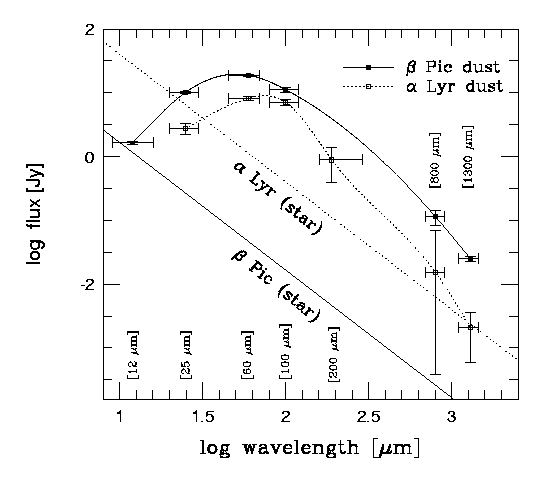
 Dust in Beta Pic
Dust in Beta Pic
Many Vega-type systems turned out to be dusty disks like that around
Beta Pictoris,
here imaged in the scattered starlight:
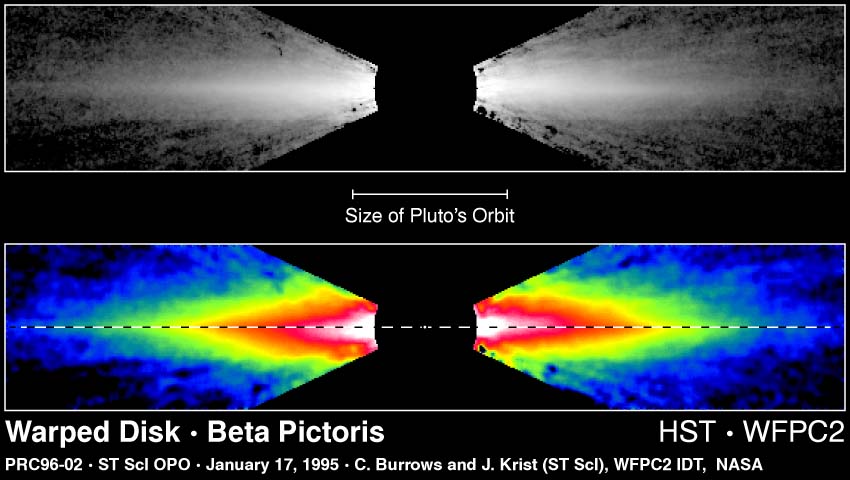
Burrows et al (1995) found that the innermost observed regions
of the disk appear warped, and proposed a giant planet inside the
the disk gap as an explanation (see below).
Lagage and Pantin (1994,1996)
obtained the first 12-micron maps showing clearly a gap and
a large inner asymmetry of dust distribution
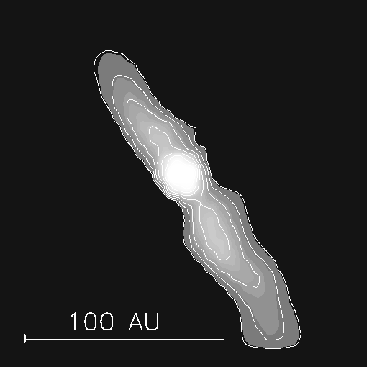
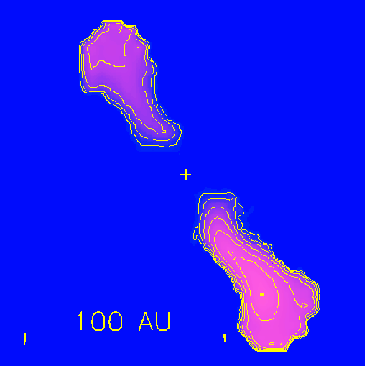
The left panel shows the 12-micron flux distribution. The right-hand side
panel shows a simple 2-D model of dust distribution that would
produce the observed flux distribution. The fairly uniform flux
distribution corresponds to an almost empty inner disk gap, because
of strong dependence of emissivity of dust
on the distance from the star. These data are now showing directly
the presence of the ~25 AU gap, whose presence but not the exact size
was known for the last decade from analyses of IR spectrum of Beta
Pic.
 Planetesimals in Beta Pic
Planetesimals in Beta Pic
Comet-sized bodies are most likely the culprits in very frequent
(up to a few hundreds a year) spectroscopic events, during which
narrow circumstellar absorption lines are distorted, indicating
the presence of gas clouds (comae) partially covering the star
and moving toward it (rarely away from it) with velocity of
dozens to hundreds km/s.
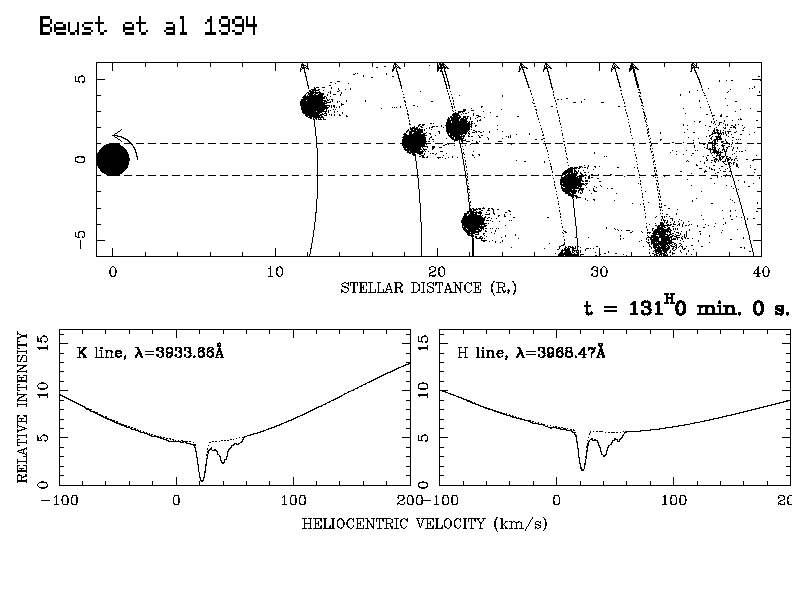
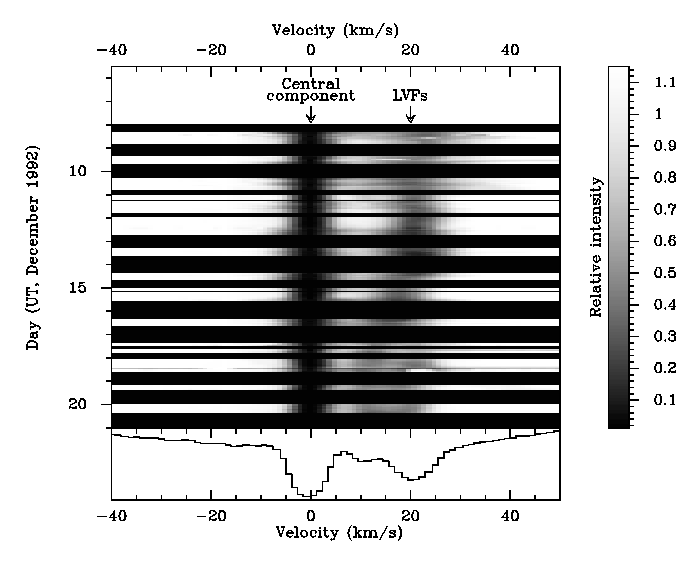
 Planets?
Planets?
Burrows et al. (1996) and
Mouillet et al. (1997) proposed that
the apparent slight warp in the innermost coronographically observed
disk region (30-100 AU from the star) is caused by a Jovian-type
planet orbiting inside that region on a slightly inclined (i=3o)
orbit.
See the new
ESO press release about the latter work.
Lecavelier des Etang
et al (1996) found unusual brightening around Nov 10, 1981.
The control stars that same night (lower panel) behaved normally.
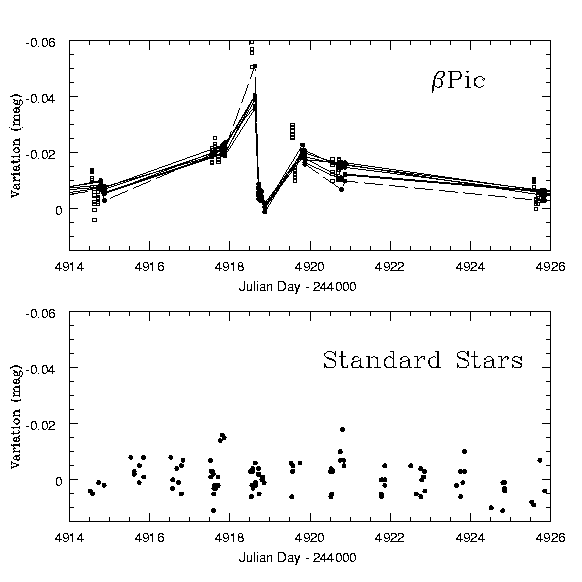
 Dynamical
theory of dust in Beta Pic
Dynamical
theory of dust in Beta Pic
The theory of dust dynamics and processing in the
disk requires the existence of a young planetesimal
system (~100 Myr old), comparable in mass with all the solids in the
solar system ( Artymowicz & Clampin 1997)

Beta Pictoris - a young solar system
Artymowicz (1997,
Ann.Rev.Earth&Planet.Sci.)
| Similarities |
Dissimilarities |
- Dust-dominated thin disk
- Grey scattering, ~15% polarization, and
- Size distribution of grains (mostly
by 2--20 microns)
- Composition (= comets,asteroids)
- warm amorphous silicates (<40 AU)
- warm crystalline silicates
- cold main disk (bright olivine/pyroxene
preferred)
- ices photoevaporated?
- Nearly gas-free (by mass)
- Total solids >~100 Earth masses (~` Earth mass directly
observed)
- Dust replenished in 104 yr << age (20-100 Myr)...
- ...by the same mechanisms (collisions of meteoroids,
evaporation & photosputtering of icy planetsimals).
- Planetesimals:
- FEB=Falling Evaporating Bodies,
in large numbers --> like a young solar system
- the largest maintain disk thickness(?)
- release gas, produce slowly varying & stable
absorpotion
- Planet(s) invoked to explain:
- the inner clearing (40 AU)
- its asymmetric dust distribution
- the warp at r=30-80 AU
- send planetesimals onto the star
- send planetesimals to r>1000 AU
- produce Nov 1981 brightening
- A clearing stage of a planetary system
|
- 104 more dust than in the Zodiacal Light and Kuiper belt
- up to 108 times larger dust grinding rate
- Larger than standard solar nebula
- More asymmetric than ZL
- Brighter dust (A>0.4),
- Dust contains little C and Fe (Fe:Mg < 0.3
while in the chondritic composition Fe:Mg ~0.8)
- Larger role of radiation pressure
- Dust avalanches may occur
|
Key resolved problems:
- The disk mapped out and understood at some level
- Beta Pic is a young main-sequence star (d=19.2 pc)
- Beta Pic is not unique observationally
(cf. SAO 26804, BD +31o 643)
- Beta Pic appears uniquely dusty,
but its extreme dustiness is temporary
- Beta Pic has less prominent cousins around a
fraction of all main-sequence stars (>10%)
Key unresolved problems:
- Disk asymmetries
- Dust: from colliding/eroded, or evaporating planetesimals?
- Planets?
 table of
contents
table of
contents
 next topic
next topic
![]() In 1983, IRAS discovered excessively IR-emitting stars, or
Vega-type systems
In 1983, IRAS discovered excessively IR-emitting stars, or
Vega-type systems







